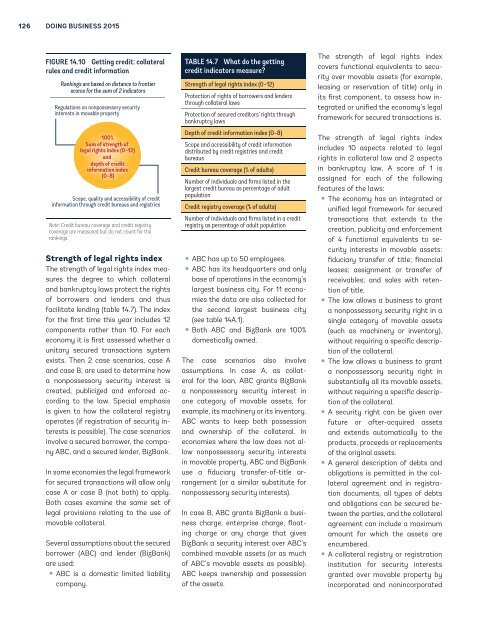bc8G2-7
bc8G2-7
bc8G2-7
You also want an ePaper? Increase the reach of your titles
YUMPU automatically turns print PDFs into web optimized ePapers that Google loves.
126<br />
DOING BUSINESS 2015<br />
FIGURE 14.10 Getting credit: collateral<br />
rules and credit information<br />
Rankings are based on distance to frontier<br />
scores for the sum of 2 indicators<br />
Regulations on nonpossessory security<br />
interests in movable property<br />
100%<br />
Sum of strength of<br />
legal rights index (0–12)<br />
and<br />
depth of credit<br />
information index<br />
(0–8)<br />
Scope, quality and accessibility of credit<br />
information through credit bureaus and registries<br />
Note: Credit bureau coverage and credit registry<br />
coverage are measured but do not count for the<br />
rankings.<br />
Strength of legal rights index<br />
The strength of legal rights index measures<br />
the degree to which collateral<br />
and bankruptcy laws protect the rights<br />
of borrowers and lenders and thus<br />
facilitate lending (table 14.7). The index<br />
for the first time this year includes 12<br />
components rather than 10. For each<br />
economy it is first assessed whether a<br />
unitary secured transactions system<br />
exists. Then 2 case scenarios, case A<br />
and case B, are used to determine how<br />
a nonpossessory security interest is<br />
created, publicized and enforced according<br />
to the law. Special emphasis<br />
is given to how the collateral registry<br />
operates (if registration of security interests<br />
is possible). The case scenarios<br />
involve a secured borrower, the company<br />
ABC, and a secured lender, BizBank.<br />
In some economies the legal framework<br />
for secured transactions will allow only<br />
case A or case B (not both) to apply.<br />
Both cases examine the same set of<br />
legal provisions relating to the use of<br />
movable collateral.<br />
Several assumptions about the secured<br />
borrower (ABC) and lender (BizBank)<br />
are used:<br />
• ABC is a domestic limited liability<br />
company.<br />
TABLE 14.7 What do the getting<br />
credit indicators measure?<br />
Strength of legal rights index (0–12)<br />
Protection of rights of borrowers and lenders<br />
through collateral laws<br />
Protection of secured creditors’ rights through<br />
bankruptcy laws<br />
Depth of credit information index (0–8)<br />
Scope and accessibility of credit information<br />
distributed by credit registries and credit<br />
bureaus<br />
Credit bureau coverage (% of adults)<br />
Number of individuals and firms listed in the<br />
largest credit bureau as percentage of adult<br />
population<br />
Credit registry coverage (% of adults)<br />
Number of individuals and firms listed in a credit<br />
registry as percentage of adult population<br />
• ABC has up to 50 employees.<br />
• ABC has its headquarters and only<br />
base of operations in the economy’s<br />
largest business city. For 11 economies<br />
the data are also collected for<br />
the second largest business city<br />
(see table 14A.1).<br />
• Both ABC and BizBank are 100%<br />
domestically owned.<br />
The case scenarios also involve<br />
assumptions. In case A, as collateral<br />
for the loan, ABC grants BizBank<br />
a nonpossessory security interest in<br />
one category of movable assets, for<br />
example, its machinery or its inventory.<br />
ABC wants to keep both possession<br />
and ownership of the collateral. In<br />
economies where the law does not allow<br />
nonpossessory security interests<br />
in movable property, ABC and BizBank<br />
use a fiduciary transfer-of-title arrangement<br />
(or a similar substitute for<br />
nonpossessory security interests).<br />
In case B, ABC grants BizBank a business<br />
charge, enterprise charge, floating<br />
charge or any charge that gives<br />
BizBank a security interest over ABC’s<br />
combined movable assets (or as much<br />
of ABC’s movable assets as possible).<br />
ABC keeps ownership and possession<br />
of the assets.<br />
The strength of legal rights index<br />
covers functional equivalents to security<br />
over movable assets (for example,<br />
leasing or reservation of title) only in<br />
its first component, to assess how integrated<br />
or unified the economy’s legal<br />
framework for secured transactions is.<br />
The strength of legal rights index<br />
includes 10 aspects related to legal<br />
rights in collateral law and 2 aspects<br />
in bankruptcy law. A score of 1 is<br />
assigned for each of the following<br />
features of the laws:<br />
• The economy has an integrated or<br />
unified legal framework for secured<br />
transactions that extends to the<br />
creation, publicity and enforcement<br />
of 4 functional equivalents to security<br />
interests in movable assets:<br />
fiduciary transfer of title; financial<br />
leases; assignment or transfer of<br />
receivables; and sales with retention<br />
of title.<br />
• The law allows a business to grant<br />
a nonpossessory security right in a<br />
single category of movable assets<br />
(such as machinery or inventory),<br />
without requiring a specific description<br />
of the collateral.<br />
• The law allows a business to grant<br />
a nonpossessory security right in<br />
substantially all its movable assets,<br />
without requiring a specific description<br />
of the collateral.<br />
• A security right can be given over<br />
future or after-acquired assets<br />
and extends automatically to the<br />
products, proceeds or replacements<br />
of the original assets.<br />
• A general description of debts and<br />
obligations is permitted in the collateral<br />
agreement and in registration<br />
documents, all types of debts<br />
and obligations can be secured between<br />
the parties, and the collateral<br />
agreement can include a maximum<br />
amount for which the assets are<br />
encumbered.<br />
• A collateral registry or registration<br />
institution for security interests<br />
granted over movable property by<br />
incorporated and nonincorporated


